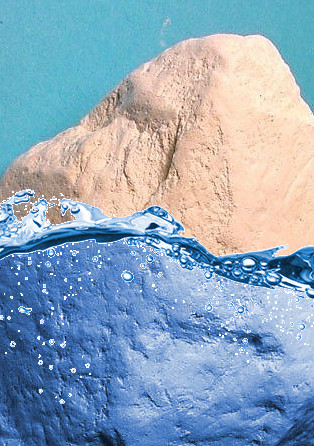Subduction effect checked

Researchers have studied how a particular clay mineral can create huge underground oceans.
A German team has reported the first observations of a super-hydrated phase of the clay mineral kaolinite in conditions similar to those in ‘subduction zones’, where an oceanic plate dives under the continental crust.
They were able to observe the transport and release of water during subduction, which causes strong volcanic activity.
In a subduction zone, a heavy oceanic plate meets a second, lighter continental plate and moves under it and into the earth's mantle.
With the oceanic plate, water enters the earth as it is trapped in minerals of the oceanic crust or overlaying sediments.
These minerals slowly sink deeper into the mantle over millions of years. With increasing depth, temperature and pressure, the minerals become instable, break down and transform into new compounds.
During these transformations, water is released and rises into the surrounding, hotter mantle where it decreases the melting temperature of the mantle rock.
“When the mantle rocks melt, magma is generated. This can lead to volcanic activity when the magma rises to the surface,” explains researcher Yongjae Lee.
“While we know that the water cycle in subduction zones influences volcanism and possibly seismicity, we don't know much about the processes that form this cycle.”
Since these processes take place many kilometres under Earth's surface, it is impossible to observe them directly.
One way to learn more about the transformations in greater depths of subduction zones is to create similar conditions in the laboratory.
High-pressure and high-temperature measurements allow scientists to take a close look at the structural changes in the different minerals that form the crust and sediments.
One of these minerals is kaolinite, a clay mineral containing aluminium that is an important part of the oceanic sediments.
In the latest study, scientists were able to observe the formation of a new phase of the mineral, called super-hydrated kaolinite.
They examined a sample of kaolinite in the presence of water at pressures and temperatures corresponding to those at different depths in subduction zones. With X-ray diffraction and infrared spectra measurements, structural and chemical changes were characterised.
At a pressure of circa 2.5 Giga-Pascal (GPa), more than 25,000 times the average pressure at sea level, and a temperature of 200 degrees Celsius, the super-hydrated phase was observed.
These conditions are present at a depth of about 75 kilometres in subduction zones.
In the new phase, water molecules are enclosed between the layers of the mineral. The super-hydrated kaolinite contains more water than any other known aluminosilicate mineral in the mantle.
When pressure and temperature sink back to ambient conditions, the structure reverts to its original form.
They found that the super-hydrated kaolinite broke down at 5 Giga-Pascal and 500 degrees, with two additional transformations happened at higher pressures and temperatures.
During these transformations, the water held in the kaolinite is released.
The release of water that takes place when the super-hydrated kaolinite breaks down could be an important part of the water cycle that causes volcanism along subduction zones.
The breakdown probably happens below a depth of about 200 kilometres, the released water could then contribute to the formation of magma.
Additionally, the super-hydrated kaolinite could influence seismic activity.
During the formation of the new phase, the water that surrounds kaolinite is removed from the environment. This could change the friction between the subducting and the overlying slabs.
The experts say the study should help improve the understanding of the geochemical processes in subduction zones of the earth.







 Print
Print